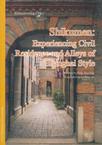石库门
出版时间:2010-1 出版社:上海人民出版社 作者:冯绍霆 页数:174 译者:李冰诗
Tag标签:无
前言
I was extremely delighted to accept the job of writing the booklet when senior editor Su Yiming from Shanghai Peoples Publishing House approached me with the request. I was born and brought up in a Shikumen building, where I spent a total of 50 years. Most of my contact with my family, classmates and friends took place in Shikumen and ! should be counted as a Shikumen man. It was true that I had written about Shikmen before, but I still felt like saying more about them. Perhaps, people like me or those who have even more experience in Shikumen will find that the description in this book do not fully match the picture in their hearts. And to that, I can only say with regret that things are never the same when viewed from different perspectives. In hearts of ten thousand people, there are ten thousand views of Shikumen. I will be gratified if the readers simply agree that what the book describes is a real part of Shikumen. It is indeed a broad topic. As for those who have only a limited knowledge of Shikumen, I will feel greatly honored if the book helps them form even a rough impression.
内容概要
This book gives a brief and vivid introduction of the architectural style, origin, changes and structural features of Shikumen. a type of unique civil residence in Shanghai. Apart from the customs and daily life of the people living in old Shanghai alleys, folklores and funny stories that happened behind black-painted gates, the author introduced anecdotes of celebrities and Shikumen in old Shanghai. new development of Shikumen ( such as Xintiandi), and also provided a guide to major scenic spots in Shikumen. The book helps its readers to gain a general knowledge of the unique civil residences in Shanghai, and to understand the influence of the living environment upon the characters of the Shanghai people that are most well known for their "shrewdness" and "meticulousness". The book is full of information, and. in a humorous and easy manner, presents to the readers with the knowledge and the history of Shikumen. It is easy to read and interesting, with a number of legendary and touching stories. Besides. it is pleasing to the eyes with many nice photos and historical pictures that lead one into a fascinating world.
书籍目录
Introduction: Shikumen, Shanghais TrademarkChapter One Shikumen: Time-honored Civilian Residence of Shanghai Style1.1 Shanghai was once a sea of Shikumen1.2 Shigumen or Shikumen?1.3 The origin of Shikumen1.4 The upgraded Shikumen1.5 The landlord1.6 The sublessor1.7 Dwellings of the immigrantsChapter Two Experiencing Shikumen Alleys2.1 Alley vendors in Lu Xuns works2.2 "Four Heavenly Guardians"—— special breakfast in old Shanghai2.3 Stalls of shoe-maker, hair dresser, pan repairer, and books2.4 Stores in the alleys2.5 Big businesses in small alleys2.6 Symphony of the alley2.7 Behind the black gate2.8 Traditional games in old alleysChapter Three A Place of Crouching Tigers: Anecdotes of Celebrities in Old Residence3.1 Chiang Kai-shek and Shikumen3.2 Where the red flag was raised3.3 Where the stars shone3.4 "Garret Writers"Chapter Four The New Look of Shikumen4.1 "No Peeing Here!"4.2 Being shrewd about living conditions4.3 Trend of home exchange and renovation4.4 A reluctant farewell to old Shikumen4.5 Renewal of ShikumenChapter Five Snapshots of Shikumen5.1 "Red sacred place"—— Old and New Yuyangli5.2 "Stronghold of the underground battle"—— Shenchengli5.3 "The Upper Side" —— Xiafeifang5.4 "Cradle of celebrities"—— Wanyifang5.5 "Many a first"——Tangjialong5.6 A major spot of money shops —— Xingrenli5.7 A place covered with hardware shops—— Zundeli5.8 Former red-light district—— Huileli5.9 A Stronghold of Japanese secret agents—— Zhexingli5.10 An unfinished tourist map of ShikumenReferencesPostscript
章节摘录
Zou Taofen, the famous patriot, lived in No. 53 Wanyifang from 1930 to 1936. The building is now the Taofen Memorial. Quite a few other celebrities also used to live there: Hu Dunfu, famous mathematician and founder of Datong University, lived in building No. 13; Qian Xingcun, a notable writer with a rich collection, lived in building No. 38; Ding Ling, the famous writer, lived in No. 60, where she gave birth to her child with Hu Yepin and received the terrible news that her husband had been murdered. The name of Zhu Zhiyao might not be familiar to the people of todays Shanghai. He was once a man of great fame. Enterprises like Qiuxin Shipyard, Tongchang Textile Mill, and Tongchang Oil Plant were all founded by Zhu. After the 1911 Revolution, he became Chairman of the Labor Party of the Republic of China, which was founded by him and another famous socialist, Xu Qiwen, who served as the Vice Chairman and was later killed by Yuan Shikai. Zhus fame didnt stem merely from his identity as a devout Catholic. His ancestors had been faithful Catholics since the late Ming Dynasty and early Qing Dynasty, and so were his relatives. His uncle was Ma Xiangbo, who founded Zhendan University and later Fudan University. After the Opium War, the Catholic Church built Dongjiadu Cathedral in Shanghai. The Zhu family moved to live next to the Cathedral and was known as the Zhu family of Dongjiadu. In 1946, Zhu Zhiyao spent his fortune on almsgiving—— a Catholic concept whose Buddhist equivalent is "making a contribution" and is often known to people as "doing good deeds".
图书封面
图书标签Tags
无
评论、评分、阅读与下载
用户评论 (总计0条)
推荐图书
- 世界十大发明家
- 世界十大政治家
- 经学通论
- 世界十大法学家
- 世界十大军事家
- 世界十大著名妇女
- 影响未来的十大科技
- 世界十大禁书
- 新日本语能力考试N1文字词汇解说篇
- 世界十大学府
- 世界十大文化遗产
- 燕行录研究
- 夺标新学径·左讲右练 世界历史九年级上(人教版)2012年5月印刷
- 三国演义连环画
- 纪宇爱情诗 (平装)
- 中国对外贸易出口结构研究
- 新课标小学生多功能数学词典
- 诗忆六十年
- 中国诗歌大辞典 (平装)
- 交流500kV及以下纸或聚丙烯复合纸绝缘金属套充油电缆及附件(第5部分):压力供油箱 (平装)
- 音乐学论文写作教程
- 粮油检验 小麦粉面包烘焙品质试验直接发酵法 (平装)
- 大学英语六级考试实战指南
- 大学韩国语
- 大学英语泛听
相关图书
- 中文版AutoCAD 2010机械设计实践案例与练习
- 十届全国人大常委会专题讲座
- 走遍中国
- 幼儿好品质故事会(第一辑)
- 托马斯.阿奎那 讲的“信仰”的故事
- 质量管理体系 要求
- 高中英语词汇全解
- 2009阿坝州年鉴
- 生活短笛:陈祥龙散文精选 (平装)
- 韩国语能力考试必备中级阅读
- 中华民国史辞典
- 节能减排工程技术与应用案例
- 三毛作品集
- iLike就业Photoshop CS4 中文版多功能教材
- 潍坊年鉴2009
- 度祥·秘笈与我的尸体
- 水产饲料安全性评价亚急性毒性试验规程 (平装)
- 环球银幕 黄金时代的100位女星
- 植物百科知识
- 服装人体工学
- 超越型企业的十二突破
- 2011考研心理学考点集萃
- 儿童快乐成长-阅读·动物百科(套装全4册)
- 幼儿好品质故事会(第一辑)
- 中华人民共和国五十年文学名作文库.报告文学卷(套装上下册) (平装)
